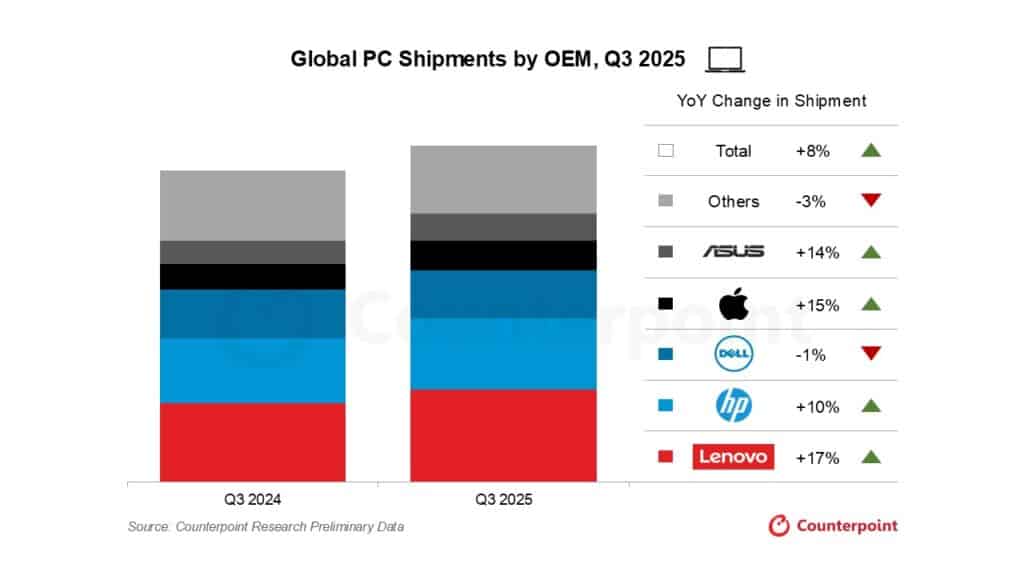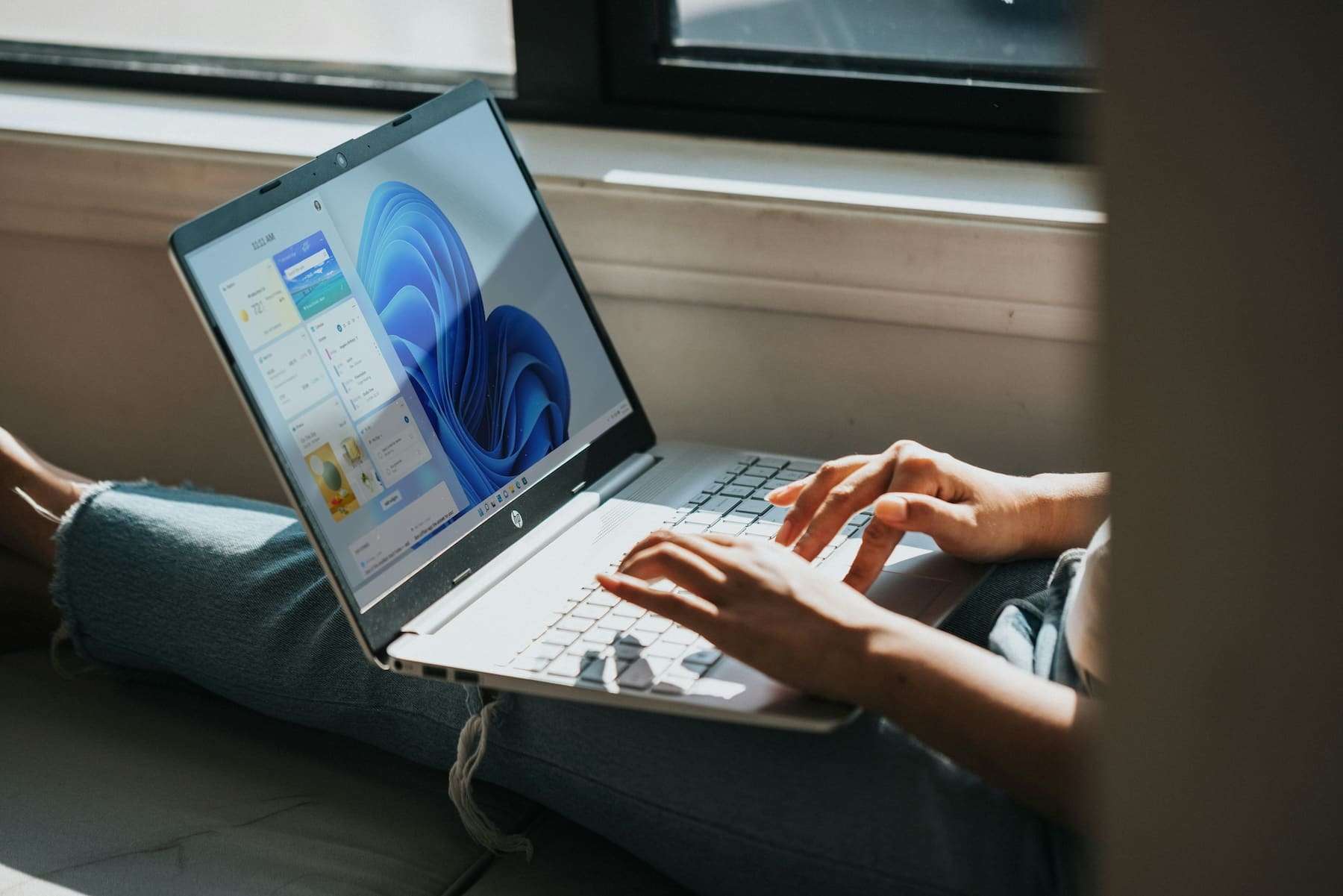Mission accomplished. The “blackout” of Windows 10 in October 2025 has served as a global renewal timer. According to preliminary data from Counterpoint Research, PC shipments increased by 8.1% year-over-year in the third quarter of 2025, driven by the end of support for the veteran system and inventory adjustments prompted by new tariff dynamics in the United States. Meanwhile, the industry is preparing for the next phase of the decade: the AI PC, which analysts see as a major catalyst starting in 2026.
A “deadline” that rekindles the replacement cycle
With almost 40% of the installed base still on Windows 10 mid-year, the end of support has become a strong purchase driver for both companies and consumers. The result is a synchronized rebound in the market in Q3 2025 — the best annual pace since the post-pandemic era — which, in the eyes of analysts, won’t end in the fourth quarter: the migration cycle will extend for several years, especially in large organizations with broad fleets.

This tailwind is complemented by inventory movements in the channel to anticipate potential tariff changes in the US, prompting some manufacturers and distributors to reallocate stock and accelerate purchases.
Who’s gaining (and who’s stagnating)
The competitive landscape this quarter is clear: the five giants capture nearly three-quarters of the market and are better capitalizing on the Windows 10 refresh.
- Lenovo remains leader and posts the biggest growth among the top six: +17.4% YoY.
- HP consolidates second place with +10.3% YoY, boosted by the enterprise segment.
- Dell holds firm, but drops by 0.9% YoY (though it registers a +2.7% QoQ increase), reflecting stricter corporate buying in key niches.
- Apple rises by +14.9% YoY driven by new MacBooks and enterprise adoption.
- Asus shines in the short term: +22.5% QoQ and +14.1% YoY thanks to strong demand for consumer laptops.
In contrast, smaller OEMs show flat or declining volumes, a sign of consolidation at the high end of the market.
Minsoo Kang, senior analyst, summarizes: “While current growth is mostly driven by OS migration, the more profound transformation will come with the AI PC. That next cycle isn’t fully reflected in the numbers for Q3 2025 yet.”
AI PC: high expectations, massive impact starting in 2026
2025 has seen the commercial debut of the “AI PC” term and portable devices with local AI acceleration (NPUs, on-chip engines). Vendors speak of generative assistants and LLMs that run offline, enhancing privacy, latency, and cost per task. But, for now, this powerful demo message has not yet translated into a dominant sales engine: buyers continue to prioritize compatibility (Windows 11), performance, and battery life.
The fundamental bet is on the future: many companies include AI capabilities in their purchases not for immediate needs, but to future-proof. Essentially, they renew now with AI-capable devices to avoid becoming obsolete in one or two years, once use cases are more mature.
The real leap in AI PC shipments will come after 2026, when mass production of platforms designed for AI on the device begins:
- Qualcomm has introduced its Snapdragon X2 Elite for PCs, featuring high-performance NPU.
- Intel is preparing Core Ultra “Panther Lake” with integrated AI engines.
- NVIDIA collaborates with ARM CPU partners (like MediaTek) on designs featuring GPU acceleration for on-device AI.
Counterpoint projects volumes in late 2026 and broad deployment in 2027. In other words: the AI PC boom as a mainstream segment will happen post-2026, raising new demand floors in the PC market during the second half of the decade. It’s no coincidence that the industry is eyeing CES 2026 as a showcase for demos and full lines of AI PCs.
David Naranjo, associate director, contextualizes: “The uptick in 2025 is not just about replacement; it’s about preparing for what’s coming. Many companies are choosing AI-capable PCs to shield their fleets, even if they don’t plan to use those features right away. The next cycle will be defined not just by performance but by edge intelligence.”
Why it matters (beyond the headline)
- Windows 10 as an “industrial clock”
The end of support has acted as a deadline that organizes IT spending. It’s a reminder that software cycles still shape hardware cycles. And, with 40% of the fleet still on Win10 mid-year, the run-rate of upgrades will continue into 2026. - Consolidation up, pressure down
The big players capture demand and profitability. For smaller vendors, competing on price alone is not enough: they need clear propositions (design, verticals, managed services) or niche. - AI PC: expectations vs. reality
The narrative around AI is strong, but the actual usage remains incipient. The second wave will arrive when applications (office tools, creation, security, analytics) capitalize on NPUs in a visible and standardized way. - Tariffs and inventories
US tariff dynamics have introduced noise into the channel (reallocation of stock, pre-purchasing). It’s a tactical factor, not structural, but helps explain spikes.
Implications for businesses and consumers
- Businesses
- If Win10 is still in your fleet, prioritize migration (security and compliance).
- Evaluate AI-capable as a criterion: NPU, memory, batteries, silicon security. Don’t pay for just the sticker if there’s no clear use case, but avoid bottlenecks in 18-24 months.
- Focus on standardization (images, drivers) and management (MDM) to prevent edge AI from becoming silos.
- Consumers
- If upgrading from an old Win10 PC, updating now makes sense (better CPU/GPU, battery life, Wi-Fi 7, AI cameras).
- If your current device meets your needs and you’re interested in AI PC, you can wait for the 2026–2027 wave for clearer gains.
What to watch in 2026
- Key benchmarks for NPU (not just theoretical TOPS): latency and efficiency in translation, summarization, assistants, and local vision.
- Real integration with Windows, Office, and security suites: how much click reduction does on-device AI provide?
- Hybrid models (local + cloud) and privacy/data policies.
- Range of offerings: from ultraportables at 15 W to powerful workstations with NPU + GPU.
Frequently Asked Questions
When does Windows 10 support end?
October 2025 is the date for end of mainstream support (excluding ESU). It’s the main driver of the current replacement cycle.
Should I buy a PC now or wait for the “AI PCs” of 2026–2027?
If your Win10 device no longer performs or poses a risk, upgrading now delivers performance, battery life, and compatibility with Win11. If you can wait and are interested in local AI, the 2026–2027 wave will bring more mature platforms.
Which brands grew the most in Q3 2025?
Lenovo (+17.4% YoY) leads the growth; HP (+10.3%), Apple (+14.9%), and Asus (+14.1% YoY, +22.5% QoQ) are also climbing. Dell drops 0.9% YoY but gains 2.7% compared to the previous quarter.
What exactly is an “AI PC”?
A PC with built-in AI accelerators (NPU/on-chip engines) capable of running models and assistants directly on the device (translation, summarization, vision tasks, productivity apps) with low latency and improved privacy, without always relying on the cloud.
Source
Counterpoint Research — Global PC Shipments Rise 8.1% YoY in Q3 2025 as Windows 10 Sunset, Tariff Dynamics Spur Market Recovery

